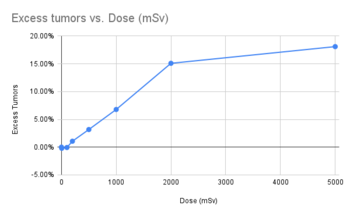Fear of radiation/Debate Guide: Difference between revisions
(add CNN articles stoking fear) |
(add responses) |
||
| Line 30: | Line 30: | ||
"These rods are “so incredibly hot, it’s very hard to transport them safely,” said Schreurs. So for now they’re being stored in containers where they can first cool down over several decades, she added."<br> | "These rods are “so incredibly hot, it’s very hard to transport them safely,” said Schreurs. So for now they’re being stored in containers where they can first cool down over several decades, she added."<br> | ||
"Communications experts are already working on how to tell future generations thousands of years from now – when language will be completely different – not to disturb the site."<br> | "Communications experts are already working on how to tell future generations thousands of years from now – when language will be completely different – not to disturb the site."<br> | ||
'''Responses:'''<br> | |||
[https://whatisnuclear.com/greenpeace-radiocarbon-wrong.html ''Greenpeace, CNN, The Hill miss context on radiocarbon release''], Nick Touran, Ph.D., P.E., WhatIsNuclear.com, October 25, 2020.<br> | |||
"a grand total of 0.4 grams of C14 in all the tanks combined." (63.6 giga-Becquerels (GBq) of radioactivity). Giga sounds really huge, but compare this to the 85 million GBq from Chernobyl, or the 15 million million GBq already in the ocean, mostly from natural Potassium-40. See this [https://www.whoi.edu/multimedia/source-of-radioactivity-in-the-ocean chart] from Woods Hole Oceanographic Institution for the sources of ocean radioactivity.<br> | |||
Revision as of 15:09, 10 May 2023
Nuclear power is a controversial topic, and some of the controversies remain unsettled, even after the facts in the article are agreed on. This Debate Guide will provide a concise summary from each side of these unsettled issues. Much of this discussion is collected from Internet forums and other unreliable sources. We welcome updates with better sourcing.
LNT Controversy
There is endless debate in social media over whether the Linear No Threshold (LNT) model should be used for accessing public health risks from low levels of radiation. Fig.A is the data of Fig.1 from a 52 year study of Japanese bomb survivors, with added columns for a linear fit and for the predicted excess tumors.
Fig.B is the data re-plotted on a linear scale.
The LNT model is a good fit for exposures above 200mSv, ignoring the highest point, where we might expect some kind of saturation. (A better fit would have the threshold at 100mSv, not zero.)
The controversy is over exposures less than 200mSv. If your exposure is between 5 and 100mSv, LNT predicts your chances of getting cancer are 0.75% higher than the normal 21%. The data from this study shows -0.07% (less cancer, not more).
Mainstream media on radiation danger
Fukushima water release could change human DNA
Amy Woodyatt and Yoko Wakatsuki, CNN.com, October 24, 2020.
"Contaminated water that could soon be released into the sea from the Fukushima Daiichi nuclear power plant contains radioactive carbon with the potential to damage human DNA"
"1.23 million metric tons of water stored at the plant"
"serious long-term consequences for communities and the environment"
"storage space is running out, and the government is still deciding what to do with the water."
"in addition to radioactive isotope tritium, contains radioactive isotope carbon-14, which is “major contributor to collective human radiation dose and has the potential to damage human DNA."
Germany is closing all its nuclear power plants. Now it must find a place to bury the deadly waste for 1 million years Sheena McKenzie, CNN.com, November 30, 2019.
"CNN — When it comes to the big questions plaguing the world’s scientists, they don’t get much larger than this. Where do you safely bury more than 28,000 cubic meters – roughly six Big Ben clock towers – of deadly radioactive waste for the next million years? This is the “wicked problem” facing Germany as it closes all of its nuclear power plants in the coming years, "
"The technological challenges – of transporting the lethal waste, finding a material to encase it, and even communicating its existence to future humans – are huge.
But the most pressing challenge today might simply be finding a community willing to have a nuclear dumping ground in their backyard."
"high-level radioactive waste is the most lethal of its kind. It includes the spent fuel rods from nuclear power plants. “If you opened up a canister with those fuel rods in it, you would more or less instantly die,” said Schreurs."
"These rods are “so incredibly hot, it’s very hard to transport them safely,” said Schreurs. So for now they’re being stored in containers where they can first cool down over several decades, she added."
"Communications experts are already working on how to tell future generations thousands of years from now – when language will be completely different – not to disturb the site."
Responses:
Greenpeace, CNN, The Hill miss context on radiocarbon release, Nick Touran, Ph.D., P.E., WhatIsNuclear.com, October 25, 2020.
"a grand total of 0.4 grams of C14 in all the tanks combined." (63.6 giga-Becquerels (GBq) of radioactivity). Giga sounds really huge, but compare this to the 85 million GBq from Chernobyl, or the 15 million million GBq already in the ocean, mostly from natural Potassium-40. See this chart from Woods Hole Oceanographic Institution for the sources of ocean radioactivity.

